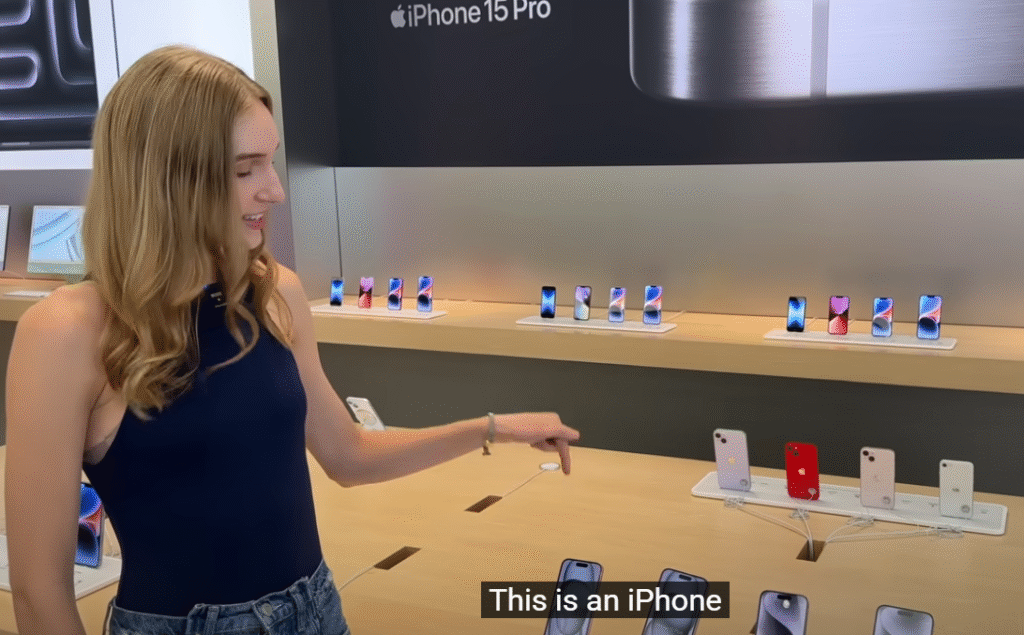The Apple Store might not be the first place that comes to mind when you think about learning English, but it’s actually an incredible real-life classroom full of conversation, technology, and opportunities to practice practical English. Whether you’re a beginner or looking to refine your language skills, the Apple Store offers a modern, interactive environment where learning becomes exciting and real. In this essay, we’ll explore how to learn English at the Apple Store—from simple greetings to tech vocabulary, customer service interactions, and even hands-on workshops that help improve your listening and speaking.

Why the Apple Store?
The Apple Store is more than just a retail space—it’s a hub for community, creativity, and communication. People from around the world visit every day, making it an ideal place for hearing natural English in action. Employees (called Apple Specialists or Geniuses) are trained in customer service and communication, so you’ll hear clear, polite English spoken at a comfortable pace.
Whether you’re buying a product, getting tech help, or attending a Today at Apple session, you’ll have plenty of chances to listen to, speak, and interact in English.
Starting with Greetings and Questions
The moment you step into an Apple Store, you’re greeted with a smile and a friendly phrase like:
- “Hi! Welcome to the Apple Store.”
- “How can I help you today?”
- “Are you looking for anything in particular?”
These greetings are great listening practice. Try responding with simple sentences:
- “Hi! I’m just looking, thank you.”
- “Yes, I want to buy an iPhone.”
- “Can you help me with my iPad?”
These small interactions help build your confidence and comfort when speaking English. Don’t worry about being perfect—what matters is trying and learning as you go.

Learn Vocabulary Through Products
Apple products introduce a wide variety of English vocabulary. By exploring different items in the store, you’ll hear and read new words like:
- Display (the screen)
- Charger (used to power your device)
- Storage (how much memory your phone or laptop has)
- Camera lens, resolution, battery life, wireless, Bluetooth, and more
You can also read the descriptions next to each product. For example, next to an iPhone, you might read:
“6.1-inch Super Retina XDR display, A15 Bionic chip, Ceramic Shield front, 5G capable”
These are great vocabulary words to learn and look up later. If you’re unsure of any word, you can politely ask a Specialist:
- “Excuse me, what does ‘retina display’ mean?”
- “Can you explain ‘storage’?”
Asking questions like this not only helps you learn new terms, but also improves your listening comprehension.
Practice Listening and Speaking
The best way to improve your English is by speaking and listening regularly—and the Apple Store gives you a perfect environment to do just that.
When speaking to an Apple employee, focus on:
- Listening carefully to their answers and explanations
- Asking follow-up questions such as:
- “Can you repeat that?”
- “What’s the difference between the iPhone 14 and 15?”
- “Is there a warranty included?”
These real conversations help you practice your listening and speaking in a meaningful way. You’re not just learning English—you’re using it for a purpose.
The Genius Bar: Learning through Service
The Genius Bar is Apple’s tech support center. If you bring in a device for help, the Apple Genius will ask questions to understand your problem and then explain how to fix it.
This is a fantastic opportunity to hear technical English in a clear, simple way. You might hear:
- “What seems to be the problem today?”
- “Let me take a look at your phone.”
- “We’ll need to update your software.”
- “Your battery health is at 80%.”
You can use this time to describe problems in English:
- “My phone won’t turn on.”
- “The screen is frozen.”
- “It’s not charging properly.”
By describing issues and listening to explanations, you naturally develop your vocabulary and sentence structure.

Attend a “Today at Apple” Session
Apple offers free workshops called “Today at Apple,” where you can learn new skills in photography, music, art, coding, and more. These sessions are taught in English and are an amazing way to learn through action.
Examples of session titles include:
- “Take Better Photos on iPhone”
- “Create Music in GarageBand”
- “Get Started with Mac”
These sessions are interactive, so you’ll listen to instructions, follow along, and sometimes even work with other participants. You’ll hear phrases like:
- “Let’s open the Photos app.”
- “Click on the plus sign.”
- “Now drag your finger across the screen.”
This environment helps you connect English with actions and technology. You’ll also hear native speakers ask questions and talk casually, which helps improve your everyday conversational English.
Use the Apple Store App
Even outside the store, you can continue learning. Download the Apple Store app or visit Apple’s website in English. Explore product pages, watch videos, read support articles, and change your phone’s language settings to English. This immerses you in technology-related English and helps you learn words in context.
You can also practice reading reviews or customer questions, such as:
- “Does this iPad work with the Apple Pencil?”
- “How long does the battery last?”
- “Is it good for students?”
Try writing your own review or pretending to ask a question in English. This is great practice for writing and reading comprehension.

Build Confidence with Repetition
If you’re nervous, try this strategy:
- Visit once just to observe. Listen to conversations around you, read signs, and look at product names.
- Visit again to practice speaking. Try asking a question or starting a short conversation.
- Repeat visits and build confidence. The more often you go, the more natural English becomes.
It’s okay to make mistakes—Apple Store employees are used to helping people from many backgrounds and will be patient with you.
Conclusion
Learning English doesn’t always mean sitting in a classroom or studying a textbook. You can learn by living—and the Apple Store is a perfect example of that. From speaking to employees, reading product labels, attending free workshops, and experiencing real-life tech situations, you can grow your English skills in a fun and modern environment.
So next time you walk past an Apple Store, don’t just look through the glass. Step in. Say hello. Ask a question. Join a session. Let your curiosity lead you—and let English become part of your everyday life. You might walk in for an iPhone, but you’ll walk out a little more fluent, a little more confident, and a lot more inspired. 📱🇺🇸



